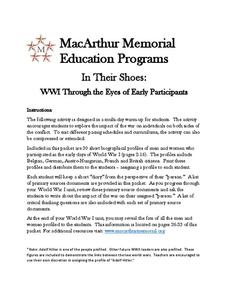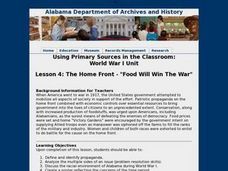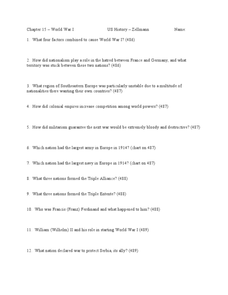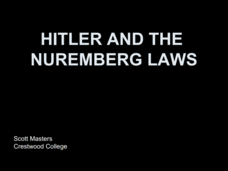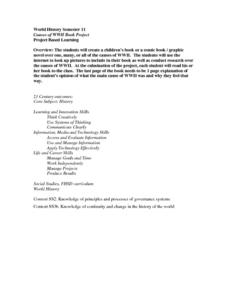Curated OER
Graphic Organizer: Holocaust
Help your class process and organize what they've learned about World War II and the Holocaust with a graphic organizer. There are four boxes on this page, two over the word Holocaust and two under. The two on top require learners to...
MacArthur Memorial
In Their Shoes: WWI Through the Eyes of Early Participants
Several social activities provide showcase the perspective of many prominent figures in World War I history. Students read an assigned case study about a memorable person and complete several activities to further understand this...
Curated OER
The Vietnam War 1954-1975
Discuss the full travesty of the Vietnam War. Whether it's for history class, Memorial Day, or Veterans Day, this slide show is sure to make an impact on learners in the upper grades. Vivid images, concise language, and the complete...
Curated OER
American Reactions to Fascist Aggression
Students consider the causes of World War II. In this origins of World War II lesson, students discuss American reactions to fascist aggression prior to the war.
Curated OER
Images at War
Students examine American attitudes toward war as revealed in Civil War photographs and WWII homefront posters. They analyze and discuss photos, explore the National Archives website, and organize a statement of their findings.
Curated OER
Freedom by the Fireside: The Legacy of FDR's "Four Freedoms" Speech
Students read and analyze Franklin Delano Roosevelt's 1941 State of the Union Address. They listen to recordings of speeches by F.D.R., answer discussion questions, and participate in a debate.
Curated OER
Origins of World War I
In this World War I worksheet, students follow the provided guidelines to conduct independent research and write research papers about aspects of the war.
Curated OER
The Home Front - "Food Will Win The War"
Students define and identify propaganda. They analyze the multiple sides of an issue (problem resolution skills), then discuss the racial environment of Alabama during World War I. They reate a poster reflecting the concerns of the time...
Curated OER
Who Started World War I?
Students debate which power was responsible for the outbreak of World War I. In this cause and effects lesson, students research the causes of the outbreak of World War I on ProQuest in preparation for a (limited) reenactment of the...
Curated OER
Chapter 15 – World War I
In this World War I activity, high schoolers read assigned textbook pages regarding the war and respond to 51 short answer questions.
Curated OER
Hitler and the Nuremberg Laws
Before you can really understand how WWII started, you need to understand the time prior to the rise of the Nazi Movement. Learn about Hitler as he grew up, rose through the military rank, and ultimately took charge of a nation. An...
University of California
The Vietnam War (1945 – 1975)
Have you ever wanted to do something so perfectly you wound up not doing it well at all? Young historians use primary and secondary documents to analyze the United States involvement in the Vietnam War. The issues surrounding the...
Curated OER
WWII Website
Tenth graders research a topic related to World War II. They explore the causes and legacy of WWII, the European Theater of Operations, the Pacific Theater of Operations, Diversity in WWII, Women in WWII, and the Homefront. Students...
Curated OER
Mapping and Personifying Nations
Eleventh graders analyze the geography, actions, and relationships of countries involved in World War II. They create a map of Europe, Northern Africa, and the Pacific, and analyze and evaluate their self-made map of Europe and the...
Curated OER
Literature and the "Age of Anxiety" (1920s and 1930s).
High schoolers examine historical events of the 1920s, World War II and the Cold War. They discover how literature reflects the economic, political, social, religious and historical concerns of a culture. Students compare literature...
Curated OER
Dr. Seuss Takes on Charles Lindbergh
Learners study the leaders of the isolationist movement within the United States and the causes of the isolationist movement, they recognize and compare the perceptions of both the isolationists within the US and those who took a more...
Curated OER
D-Day Student Worksheet
In this World War II worksheet, students read a 1-page selection about D-Day, examine the listed Internet sources on the topic, and then respond to 8 short answer questions about the information presented.
Sharp School
Causes of WWII Book Project
To conclude their study of World War II, world history students are charged with creating a children's book, comic book, or graphic novel that depicts the causes of the war. Using images from the Internet or their own illustrations,...
Curated OER
Reaction to Pearl Harbor: Japanese American Internment Camps
This student produced presentation provides a great exploration of the Japanese-American Internment Camps during World War II, but should be used primarily as a discussion tool. The presentation includes photos, audio and pictures of...
Curated OER
AGGRESSION Comprehension Worksheet
In this World War II worksheet, students respond to 10 short answer questions regarding aggression of countries that feature the letters of the word "aggression" as mnemonic hooks.
Curated OER
Great Escape Crossword
In this World War II crossword worksheet, students read 22 clues pertaining to the escape attempts of prisoners of war. Students write their answers in a crossword puzzle.
Curated OER
H4 Homework Assignment #35-39
In this global studies worksheet, learners read the noted pages in their textbooks and then respond to 5 essay and short answer questions about World War II and global regions.
Curated OER
Introduction to the Holocaust
Eighth graders examine the implications of the Holocaust. In this human justice lesson, 8th graders unknowingly participate in a segregation simulation and discuss its outcome. Students compare the simulation to the discrimination that...
Curated OER
Social Studies - Concentration Camps - 1
Young scholars compare and contrast concentration camps. In this World War II instructional activity, students examine photographs and documents from Jewish concentration camps in an effort to understand their function. Young scholars...



